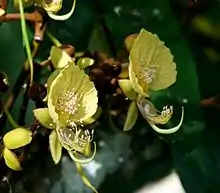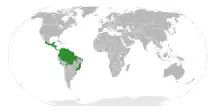Swartzieae
The tribe Swartzieae is an early-branching monophyletic clade of the flowering plant subfamily Faboideae or Papilionaceae. Traditionally this tribe has been used as a wastebasket taxon to accommodate genera of Faboideae which exhibit actinomorphic, rather than zygomorphic floral symmetry and/or incompletely differentiated petals and free stamens.[1][3] It was recently revised and most of its genera were redistributed to other tribes (Amburaneae, Baphieae, and Exostyleae).[1][4][5] Under its new circumscription, this clade is consistently resolved in molecular phylogenies.[1][4][6][7][8][9][10][2][11] Members of this tribe possess "non-papilionate swartzioid flowers[…]largely characterized by a tendency to lack petals combined with a profusion and elaboration of free stamens"[1][4] and a "lack of unidirectional order in the initiation of the stamens".[2] They also have "complete or near complete fusion of sepals resulting from intercalary growth early in development, relatively numerous stamens, and a single or no petal, with other petals not at all apparent in development."[12] The tribe is predicted to have diverged from the other legume lineages 48.9±2.8 million years ago (in the Eocene).[10]
| Swartzieae | |
|---|---|
 | |
| Swartzia picta | |
| Scientific classification | |
| Kingdom: | |
| (unranked): | |
| (unranked): | |
| (unranked): | |
| Order: | |
| Family: | |
| Subfamily: | |
| Tribe: | Swartzieae (DC. 1825) Cardoso et al. 2013[1] |
| Type genus | |
| Swartzia Schreb. | |
| Subclades and Genera | |
|
See text. | |
 | |
| Distribution of the Swartzieae | |
| Synonyms | |
| |
Subclades and genera
Swartzioids sensu stricto Ireland et al. 2000
The members of this clade occur mainly in lowland rain forests.[4][6][2]
- Bobgunnia J. H. Kirkbr. & Wiersema
- Bocoa Aubl.
- Candolleodendron R. S. Cowan
- Fairchildia Britton & Rose[2]
- Swartzia Schreb.
Atelioids Ireland et al. 2000
The members of this clade are distinguished by "a nearly actinomorphic androecium with basifixed anthers, exarillate seeds, and a tendency toward alternate leaflets."[4][2] They occur mainly in neotropical, seasonally-dry tropical woodlands.[4]
- Ateleia (DC.) Benth.
- Cyathostegia (Benth.) Schery
- Trischidium Tul.[13]
References
- Cardoso D; Pennington RT; de Queiroz LP; Boatwright JS; Van Wyk B-E; Wojciechowskie MF; Lavin M (2013). "Reconstructing the deep-branching relationships of the papilionoid legumes". S Afr J Bot. 89: 58–75. doi:10.1016/j.sajb.2013.05.001.
- Torke BM; Schaal BA (2008). "Molecular phylogenetics of the species-rich neotropical genus Swartzia (Leguminosae, Papilionoideae) and related genera of the swartzioid clade". Am J Bot. 95 (2): 215–228. doi:10.3732/ajb.95.2.215. PMID 21632346.
- Polhill RM (1994). "Classification of the Leguminosae". In Bisby FA; Buckingham J; Harborne JB (eds.). Phytochemical Dictionary of the Leguminosae, Plants and Their Constituents. 1. Chapman and Hall/CRC Press, London. pp. xxv–xlvii. ISBN 9780412397707.
- Cardoso D; de Queiroz LP; Pennington RT; de Lima HC; Fonty É; Wojciechowski MF; Lavin M (2012). "Revisiting the phylogeny of papilionoid legumes: new insights from comprehensively sampled early-branching lineages". Am J Bot. 99 (12): 1991–2013. doi:10.3732/ajb.1200380. PMID 23221500.
- Wojciechowski MF (2013). "Towards a new classification of Leguminosae: Naming clades using non-Linnaean phylogenetic nomenclature". S Afr J Bot. 89: 85–93. doi:10.1016/j.sajb.2013.06.017.
- Ireland HE; Pennington RT; Preston J (2000). "Molecular systematics of the Swartzieae". In Herendeen PS; Bruneau A (eds.). Advances in Legume Systematics, Part 9. Kew, UK: Royal Botanic Gardens. pp. 277–298. ISBN 184246017X.
- Pennington RT; Lavin M; Ireland H; Klitgaard B; Preston J; Hu J-M (2001). "Phylogenetic relationships of basal papilionoid legumes based upon sequences of the chloroplast trnL intron". Syst Bot. 55 (5): 818–836. doi:10.1043/0363-6445-26.3.537 (inactive 2021-01-17). JSTOR 3093980.CS1 maint: DOI inactive as of January 2021 (link)
- Wojciechowski MF; Lavin M; Sanderson MJ (2004). "A phylogeny of legumes (Leguminosae) based on analysis of the plastid matK gene resolves many well-supported subclades within the family". Am J Bot. 91 (11): 1846–1862. doi:10.3732/ajb.91.11.1846. PMID 21652332.
- Ireland HE (2005). "Tribe Swartzieae". In Lewis G; Schrire B; MacKinder B; Lock M (eds.). Legumes of the world. Kew, UK: Royal Botanic Gardens. pp. 214–225. ISBN 1900347806.
- Lavin M; Herendeen PS; Wojciechowski MF (2005). "Evolutionary rates analysis of Leguminosae implicates a rapid diversification of lineages during the Tertiary". Syst Biol. 54 (4): 575–594. doi:10.1080/10635150590947131. PMID 16085576.
- LPWG [Legume Phylogeny Working Group] (2013). "Legume phylogeny and classification in the 21st century: progress, prospects and lessons for other species-rich clades" (PDF). Taxon. 62 (2): 217–248. doi:10.12705/622.8. hdl:10566/3455.
- Tucker SC (2003). "Floral ontogeny in Swartzia (Leguminosae: Papilionoideae: Swartzieae): Distribution and role of the ring meristem". Am J Bot. 90 (9): 1271–1292. doi:10.3732/ajb.90.9.1271. PMID 21659227.
- Ireland HE (2007). "Taxonomic changes in the South American genus Bocoa (Leguminosae–Swartzieae): Reinstatement of the name Trischidium, and a synopsis of both genera". Kew Bull. 62 (2): 333–350. JSTOR 20443359.